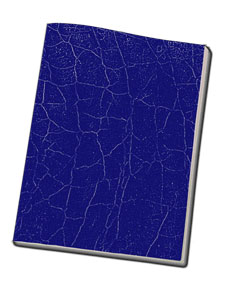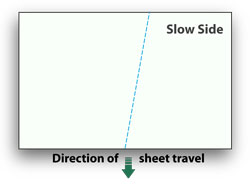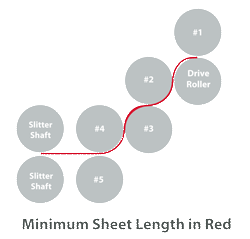Despite their versatility in the bindery, folding machines do have limitations. The bigger the diameter of the fold roller, the heavier the sheet that can be run. Grain direction also matters. But before you take the salesman’s head off for suggesting that you score and fold an 18pt cover stock, consider this technique that might help you finish an impossible job.
 If you're new to running cover stocks on the folder, you'll find you can easily hit those limits, which show up in two ways:
If you're new to running cover stocks on the folder, you'll find you can easily hit those limits, which show up in two ways:
- Excessive curl which makes it difficult or impossible to further process the sheet in the folder
- The “Alligator Skin” effect in which the paper surface wrinkles or cracks from wrapping around the fold rollers (illustration at right gives you an idea.)
Many years ago we were given a 16pt C1S cover stock to score and fold on a 26” Stahl folder using a Technifold Tri-Creaser. The first sheet out of the machine had a severe curl and severe wrinkles. At the time we had just received a tip for improving register when scoring on folding machines. We had been looking for the opportunity to try it so in a “let’s see what happens” state of mind, we decided to try it on this problem even though it was apparently unrelated.
Lo and behold, the alligator skin disappeared, the curl was drastically reduced to a manageable level and it registered perfectly.
Here’s the simple technique, which comes to us from Graham Harris of Tech-ni-fold Ltd. The job illustrated is a 4-page brochure with the score (crease) applied in the first section and the fold carried out in the right angle.
- Place one strip of the paper you’re running in fold roller caliper # 1 and one strip in the slitter shaft caliper.
- Place five strips of the same paper in calipers # 2-5.
- Check that caliper #1 and the slitter shaft caliper are set evenly and with correct tension.
- Check alignment of the side lay. The sheet should enter fold roller #1 perfectly square.

- Check that all deflectors are closed and pushed all the way into the stops.
- Run a sheet and check that the score is square to the sheet.
- If it’s not square, identify which side of the sheet is running slowest (see diagram at right) and remove 1 strip of paper from caliper #2 or 3 on the slow side. Run another test sheet and repeat process as needed until the score is square.
 The idea makes sense with regard to folding machine register; after all you only need to get the sheet to the slitter shafts to apply the score (or perf.) The other fold rollers and deflectors don’t really serve any purpose. Of course you face another limit since the sheet must be long enough to be gripped by the slitter shafts before it leave the grip of fold roller #1 (see diagram at left.) You'll need to figure this dimension for your folder.
The idea makes sense with regard to folding machine register; after all you only need to get the sheet to the slitter shafts to apply the score (or perf.) The other fold rollers and deflectors don’t really serve any purpose. Of course you face another limit since the sheet must be long enough to be gripped by the slitter shafts before it leave the grip of fold roller #1 (see diagram at left.) You'll need to figure this dimension for your folder.
Regarding the alligator skin effect and the decrease in curl, we have a hypothesis. When you open up the fold rollers with the 5 sheets, you increase the center-to-center distance of the fold rollers. In effect it’s similar to having larger diameter fold rollers; thus you can run heavier sheets.
When scoring and folding cover stocks you also want to be sure to use the ‘down’ fold plates, preferably #4 for a single fold. Click Here to read more about this technique in a previous blog post. If needed apply the technique above in the right angle section to minimize the chance for wrinkling.
Although there are still limits to what you can run, the above technique should easily increase your folding machine’s capability and turn some impossible jobs into manageable ones. If you are scoring and folding a large volume of very heavy stocks, then it might be time to consider alternate bindery equipment in which the sheet travels a flatter path. These include plow folders, card folding machines, folder gluers as well as accessories for buckle folders. It’s too much to cover here but look for upcoming articles.
As always, feel free to share your experiences and comments below!

